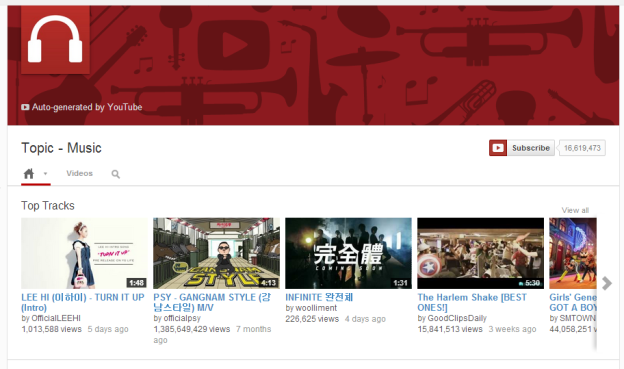
YouTube is the second largest search engine and it’s the top destination among teens to listen to music. The platform is free, save for the unavoidable ads, and you get to watch accompanying music videos to boot. It’s the perfect recipe for a streaming service – and that might be exactly what Google’s about to launch.
The Financial Times first reported on Google’s plans to take on Spotify, and The Wall Street Journal followed up with sources who’ve hinted at an upcoming YouTube music video and streaming subscription service. The video platform that’s evolved quite accidentally into a music destination site, in part thanks to its relationship with Vevo and its knack for helping with “discovering” new acts, has been courting music labels to come to an agreement with royalties as it applies to music streaming.
The latest report by Fortune based on accounts by industry insiders and an unidentified source at Google, corroborates the rumors. Google apparently isn’t going to sit still with its digital music locker service, Google Music, which was meant to be a jab at Apple’s iTunes. And why should it? YouTube isn’t ideal for music listening, so there’s obviously room for improvement in terms of its music user experience. And as we’ve mentioned already, one reason users are eating up YouTube is for its music. So why not charge these listeners instead of relying just on advertising dollars? As the Fortune article mentions, Google is one of the few companies out there that could experiment with both a subscription and advertising revenue model, or even a hybrid of both.
Based on what’s been reported YouTube might be working on a music video streaming service to highlight its strengths – namely video. Then there’s the possibility that this YouTube streaming service might compliment its service with audio-only tracks. That would make sense if YouTube ever wanted to launch the streaming service to mobile devices, keeping in mind today’s cost of consuming data. To round out the list of rumored features, tracks may be streamed for free as subscriptions would be necessary for premium features.
What distinguishes YouTube from the likes of Spotify, Rhapsody, Music Unlimited, Rdio, and other streaming apps are discover features and music charts. With YouTube syncing up with Billboard and Nielsen for an improved Billboard Chart, offering options like “New Releases” and “Top Charts” would be a cinch. But when it comes to discovering music, there’s an overlooked feature that’s been seen already in the wild that might indicate what this streaming platform might look like. What I’m referring to is YouTube’s Moodwall. This experimental project by YouTube throws together recommended videos based on “moods” like “Catchy,” “Sweet,” and “Classic” to name a few, and it’s not music-specific.
Couple this with the fact that the video platform has a vast repository of data about what you’ve watched, at what time, and for how long, and Google just released Google Sign-In, YouTube (and Google) could set itself up as a very viable option.
We’ve reached out to YouTube for comment, and we’ll update this article with any response.
Editors' Recommendations
- The best music streaming services of 2024
- What is YouTube Premium? Price, content, and more
- Music streaming services join #BlackoutTuesday to support protesters
- Apple Music still trails Spotify as growth continued for music streaming in 2019
- YouTube Music’s Spotify-esque Discover Mix now widely available


